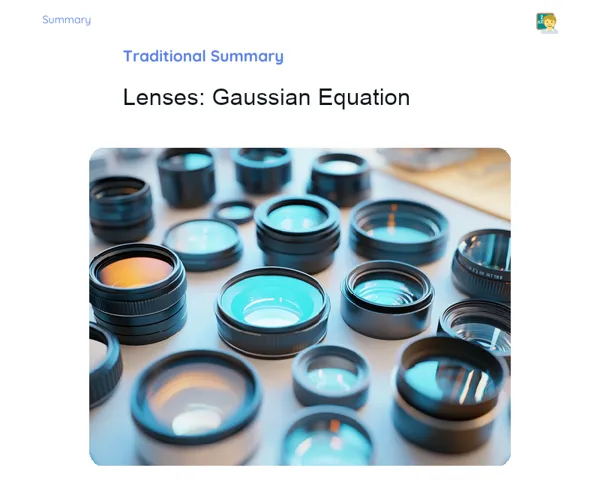Objectives
1. 🎯 Understand the concept of Simple Harmonic Motion as applied to the simple pendulum and observe how this principle appears in one of the most straightforward systems in physics.
2. 🎯 Learn to calculate key variables such as the oscillation period and gravitational acceleration using the relevant formulas for pendulum motion.
3. 🎯 Apply theoretical knowledge in real-life situations by constructing and experimenting with pendulums to see the theory in action.
Contextualization
Did you know that the simple pendulum was crucial in developing the theory of gravity by Galileo Galilei? While observing the pendulum, Galileo realized that the oscillation period is not influenced by the mass attached, but is dependent solely on the length of the string and the force of gravity. This fundamental concept not only underpins classical physics but is also utilized in modern technologies, including certain types of clocks and measuring devices!
Important Topics
Simple Pendulum
A simple pendulum is a theoretical model that consists of a point mass hanging from a lightweight string, swinging around a fixed point. The straightforward nature of this system enables a clear mathematical analysis of simple harmonic motion (SHM), aiding in comprehending oscillation period and frequency.
-
When the mass of the pendulum is displaced from its resting position and let go, it oscillates due to the gravitational force, showcasing simple harmonic motion.
-
The oscillation period of a simple pendulum depends only on the length of the string and the local gravitational pull, not on the mass of the object.
-
The formula for the oscillation period (T) is T=2π√(L/g), where L is the length of the string and g is the gravitational acceleration, highlighting the direct correlation between period and length.
Simple Harmonic Motion (SHM)
Simple Harmonic Motion refers to a type of periodic or oscillatory motion where the restoring force is proportional to the displacement and acts in the opposite direction. For a simple pendulum, SHM is observed when the angle of displacement is small, with the gravitational force acting as the restoring force.
-
The key feature of SHM is that the net force on the system is always proportional to the displacement and directed towards the equilibrium position.
-
Energy in SHM is conserved, shifting between potential and kinetic energy as the system oscillates.
-
SHM serves as an important model not just in physics but also in various fields of science and engineering, where oscillatory systems are commonplace.
Gravity Calculation
Using the simple pendulum allows for the calculation of gravitational acceleration (g) in a specific location by examining its oscillation period. According to the equations governing SHM, the pendulum's period is directly proportional to the square root of the string length and inversely proportional to the square root of gravity.
-
By measuring the oscillation period of a pendulum and knowing its string length, it is possible to rearrange the formula to calculate local gravity.
-
This application of the simple pendulum is crucial in geophysical studies and terrestrial physics, where variations in gravity are significant.
-
Using pendulums for gravity calculations was among the earliest methods to understand how gravity varies across the Earth.
Key Terms
-
Simple Pendulum: A physical system made up of a mass hung from a string, where the mass can oscillate freely under gravity's influence.
-
Simple Harmonic Motion (SHM): Oscillatory motion where the restoring force is proportional to the displacement and directed toward equilibrium.
-
Oscillation Period: The time taken for an oscillatory system to complete one cycle of motion back and forth.
-
Gravity (g): The acceleration due to gravitational force, which significantly affects the motion of objects on Earth.
For Reflection
-
How does altering the mass of the pendulum influence the oscillation period in a simple pendulum?
-
In what ways can an understanding of Simple Harmonic Motion be applied in modern technology or other scientific fields?
-
How can insights gained from simple pendulums enhance our comprehension of gravitational variations on Earth?
Important Conclusions
-
Today, we delved into the interesting world of pendulums and how they illustrate Simple Harmonic Motion (SHM). We found that the oscillation period of a simple pendulum is independent of the mass and relies solely on the string length and local gravity.
-
We learned to calculate the oscillation period using the formula T = 2π√(L/g), a vital tool for understanding not only pendulums but also other systems exhibiting SHM.
-
We explored how the concepts of pendulums and SHM relate to various contexts, from clock designs to geographical studies, highlighting the relevance and applicability of physics in our everyday lives.
To Exercise Knowledge
Calculate the oscillation period of a pendulum with varying string lengths and compare the findings. Simulate gravity changes (use hypothetical values for different planets) and observe how it influences the oscillation period. Build a simple pendulum and measure its oscillation period, verifying the formula T = 2π√(L/g) with experimental results.
Challenge
Create a DIY 'Pendulum Clock' using recyclable materials. Aim to calibrate your pendulum to maintain time as accurately as possible. Share your findings and the design of your clock with the class!
Study Tips
-
Review the formulas and concepts discussed today by making mind maps that visualize the relationships between force, motion, and energy in the context of SHM.
-
Watch videos demonstrating pendulum behavior under different conditions and try to identify the principles of SHM in action.
-
Experiment with online pendulum simulations to see how various parameters affect motion, reinforcing your theoretical understanding through virtual practice.



